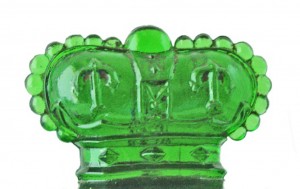William Sparks Thomson learned the ins and outs of business at an early age in his father’s grocery store in New Haven. At the age of twenty-one he left New Haven and opened a dry goods store in Hartford. In 1844, the dry goods store of Wm. S. Thomson & Co. sold bolts of fabric, ready-to-wear clothing and assorted sundries at 263 Main Street. This was the first of many companies to bear his name.
Starting about 1850, Thomson either closed or sold his Hartford store and went to work in Boston for James M. Beebe, Morgan & Co., one of the largest wholesale dry goods and importing houses in the Northeast. By 1854 Thomson was in New York, where he opened WS Thomson, a dry goods store at 162 Broadway. With his younger brother, Charles Henry, they formed the WS & CH Thomson Co., lasting from 1856 to 1867.
WS & CH Thomson & Co. specialized in mantillas — a lace or silk veil or shawl that was easily worn over the voluminous skirts of the day. The mantilla was worn all year round — lace and silk in the summer, a heavier version in the winter.
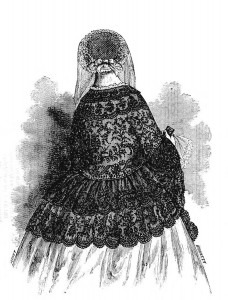
Lace Mantilla 1855 [38]
Mantles and mantelets were also manufactured by the Thomson brothers. As shown from these engravings from Godey’s Lady’s Book, these garments were elaborately decorated with embroidery and trimmings.
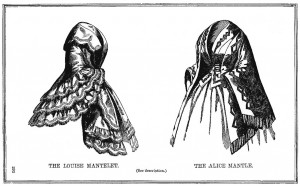

1854 [39] 1854 [40]
Many, many petticoats were needed to create the volume of the fashionable bell shaped skirts. Six to eight petticoats were worn — petticoats that wrapped around the legs and made it nearly impossible to take normal strides when walking. Petticoats were a nuisance, a burden and uncomfortable. The solution was a “skeleton” skirt (cage crinoline / hoop skirt) made of concentric metal hoops. The hoops retained their shape with a series of linen strips running from the waist to each hoop. Unfortunately the thread used to sew the linen strips to the hoops did not withstand the weight and natural swinging of the hoops. The stitching would rip, the hoops would tilt and the symmetrical bell shape would become unnaturally unsymmetrical.
![Godey's Lady's Book 1861 [41]](http://www.saltsscentsandsociety.com/wp-content/uploads/2016/02/170-300x216.jpg)
Godey’s Lady’s Book, 1861 [41]
The consequences are that a day or two’s wear of the skirt causes
almost certain derangement of the dress, and not unfrequently
the most embarrassing circumstances to the ladies when in the
drawing room or promenade. William Sparks Thomson [42]
Thomson eliminated this frequently occurring embarrassment in 1858 when he patented a metal eyelet fastener which securely attached the linen to each hoop, abolishing the need for thread and assuring a reliable silhouette. This simple metal fastener in the shape of an “H” was the most important development in the phenomenal success of the cage crinoline. Thomson would advertise these hoop skirts as “indestructible.”
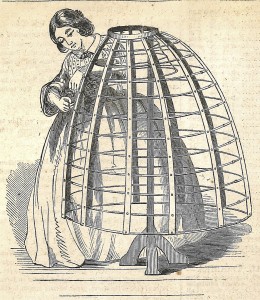
Construction of a Cage Crinoline Skirt [43]
To meet demand for Thomson’s Crown Skirts, his patented cage crinoline (hoop skirt) and his patented Watch Spring Bustle, Thomson had two factories in New York City that operated night and day. Thomson employed one thousand women in these factories, about half of whom did not have the talents necessary to be a seamstress. Although not handy with a needle and thread, they were very effective at operating the patented cutting machines for the “H” clasps and eyelets which attached the muslin tapes to the hoops. These women also operated the machines which braided the steel for the hoops. As shown in the engraving below, these non-seamstresses were involved with the actual constructions of the hoops.
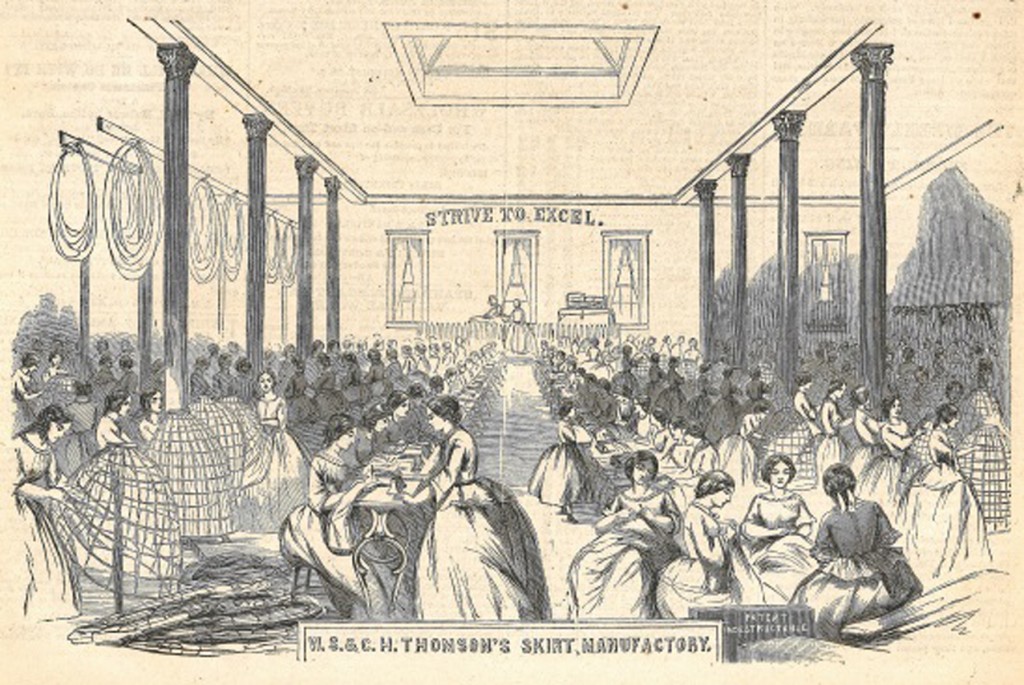
Thomson’s New York Factory 1859 [44]
When the fashionable bell shaped silhouette became the flat fronted silhouette with a bustle (tournure) in the back, Thomson’s skeleton skirts also changed shape. The flat fronted crinolines came with, or without, bustles attached.
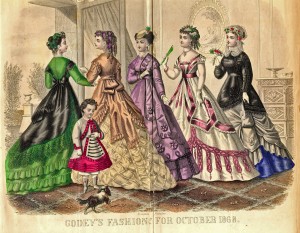
Godey’s Lady’s Book, 1868 [45]
In 1859, advertisements in the United States announced that Thomson’s skirts were used by Queen Victoria, the royal family and by the Empress of France. In 1901, The Crown Perfumery Company would advertise that England’s Queen Charlotte, European royalty and the high nobility used their perfumes.
William Sparks Thomson met his future business partner and lifelong friend, Charles H. Langdon, in Hartford, CT. Thomson had his dry goods store a block or two from Langdon & Judd, at 212 Main Street. In 1851, Langdon left his dry goods store in Hartford to work at J.C. Howe & Company, commission merchants, in Boston. Although Thomson and Langdon were once again working in the same city, albeit at different places of employment, their friendship continued. Langdon, with his brother Reuben Jr., arrived in New York around 1855 to open Langdon Brothers, a foreign dry goods importer.
Charles H. Langdon would join the Thomson brothers in 1858. With a trusted friend in New York, it was now the time to become serious about foreign factories. Thomson may have gone on a scouting expedition to England as early as May 29th, 1854 when he sailed from New York to England. London was the largest city in the world. It had twice the population of New York and Paris. Thomson was also an astute businessman. As the American Civil War approached and the South threatened to halt all cotton shipment to the Northern factories, he needed to find ways to continue manufacturing. England would not have these worries, for it was stockpiling cotton to keep its textile factories dominant. During the war years, blockade runners moved cotton from the American South to Mexico, Bermuda and the Bahamas where the bales were transferred onto British ships. Britain also increased imports of cotton from Egypt, India and Brazil.
In 1859 there are several references to William Sparks Thomson at St. Martin’s le Grand, London. There are also as many references of him living in Paris at this time.
The New York firm was renamed W.S. Thomson, Langdon & Co. in 1861. Having Langdon as resident and managing partner in charge of the New York factories, William Sparks and Charles Henry Thomson focused on England and Europe.
William Sparks Thomson created two separate companies overseas: WS & CH Thomson in London and Thomson Frères in Paris. These companies would be completely separate from New York except for their very close working relationship. London and Paris would have different stockholders and fiscal arrangements from New York, but the three companies did a brisk business when it came to the Thomson Glove Fitting Corset and The Crown Perfumery Company.
Thomson Frères in Paris was manufacturing corsets gants in 1865, while London was producing Thomson’s Glove Fitting corsets. Charles Henry Thomson lived in Paris, London and Germany, managing their many factories and showrooms.
The New York establishment of Thomson, Langdon & Co. was an importer and sole agent for Thomson’s Glove Fitting corsets. In fact, they advertised that they were importers of “French corsets.” Only in 1877 when a factory was built in Bridgeport, CT would the Thomson Glove Fitting corset be manufactured in America. The factory was built on Railroad Avenue at the corner of Myrtle Avenue in Bridgeport, Connecticut. Corsets were big business in Bridgeport, with its extensive system of railroads and shipping docks which quickly brought in the raw goods and shipped out the finished product. 1877 was also the year that L.C. and I. deVer Warner (Warner Brothers) opened a corset manufacturing plant in Bridgeport.
Just as Thomson’s cage crinoline revolutionized the fashion world, so too did his Glove Fitting corset. Thomson excelled at ready to wear corsets for all ages, for all social classes and for all activities.
The key to the success of the Thomson Glove Fitting corset was the actual construction of the corset. The Glove Fitting corset was unique it its construction. It had an extended waistband with curved top and bottom gores. While most corsets were being made from two pattern pieces, the eight pieces of Thomson’s pattern were held together by seams that ran transversely, following the natural curves of a woman’s body. Transverse seams gave a waist to the wearer. This was indeed revolutionary! Until this time, corset seams ran vertically, producing a stiff, uncomfortable tube-like fit. With transverse seams, the corset immediately hugged the body, allowing the corset to move in various directions with the wearer, and to fit “snug-as-a-glove.”
Thomson also changed the configuration of the back lacing eyelets. Rather than have the eyelets set in a zigzag pattern, he set the eyelets opposite one another. And with the addition of more eyelets, the corset could be laced tighter and more securely. Thomson’s Glove Fitting corset was a front-fastening corset with spring latches that did not open accidentally and inconveniently!
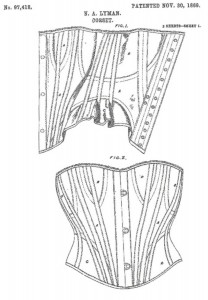
U.S. Patent 94,418 for Thomson’s Glove Fitting Corset
Henry Alexander Lyman and William Sparks Thomson were business partners in England for over 20 years. The above patent of Lyman’s was assigned to Thomson.
If the 1850s were a decade of expansion, the 1860s were a decade of international escalation. As early as 1859 there is mention of Thomson’s manufacturing enterprise in London. By 1861, the firm William Sparks & Charles Henry Thomson, was manufacturing hoop skirts and crinolines at 3 Moor Lane, Cripplegate. Established in 1861, the Parisian firm, Thomson Frères, was manufacturing corsets gants in 1865. London, Annaberg and Brussels were producing Thomson’s Glove Fitting corsets for sale throughout the world.
William Sparks Thomson’s home base in the 1860s was most likely Paris. London would be home from the 1870s onwards.
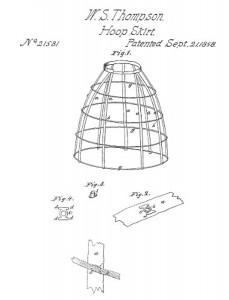
Thomson’s U.S. Hoop Skirt Patent 21,518
.
[38] Godey’s Lady’s Book. www.accessible.com. July 1855.
[39] Godey’s Lady’s Book. www. accessible.com. May 1854.
[40] Godey’s Lady’s Book. www.accessible.com. October 1854.
[41] Godey’s Lady’s Book. www.accessible.com. January 1861.
[42] Lady’s Skirt. U.S. Patent 21,581. 21 September 1858
[43] “Employment of Women. Article IV. Thomson’s Crown Skirt Factory.” Harper’s Weekly, Journal of Civilization. 19 February 1859, 125.
[44] ibid
[45] Godey’s Lady’s Book. www.accessible.com. October 1868.
.
